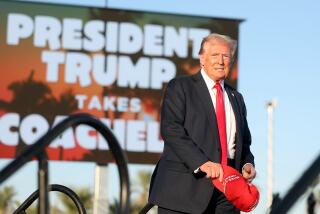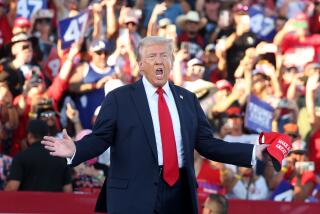Zedillo Should Have Aimed Higher
- Share via
When all the Mexican president’s men (and one woman) met to plan his visit to California they were roughly divided into two groups: those who thought President Ernesto Zedillo should look at the future and those who remembered the past.
The futurists wanted a long and triumphal tour of the state with at least two major public appearances. Those with long memories wanted a quick one-day visit, with no crowds. In typical fashion, the president gave each a bit and that is why the presidential trip to California ends today on its third day--with only tightly controlled public appearances.
Zedillo’s main goal was to mend a strained relationship with the state that is arguably the most important of the 50 American states for his nation of almost 100 million people.
That is because 2.2 million Mexican citizens are legal residents of California, and California exports more goods to Mexico than to Japan or Canada.
Yet even as Zedillo and California Gov. Gray Davis accentuated the positive, groups that disagree with Zedillo’s policies made their disagreement known with protest demonstrations during his visit.
For more than a decade, that has been par for the course whenever Mexican leaders visit California. It was first noted in 1986, when former Mexican Secretary of the Interior Manuel Bartlett came to Los Angeles to represent then-President Miguel de la Madrid in the traditional Mexican Independence “El Grito” ceremony. That night, on the steps of Los Angeles City Hall, more than 15,000 angry Mexicans jeered Bartlett, holding him personally responsible (as the cabinet minister charged with overseeing Mexico’s elections) for the widely reported fraud that had taken place earlier that year in a gubernatorial election in the state of Chihuahua.
A different kind of protester greeted former President Carlos Salinas de Gortari when he visited the state three times in the 1990s. He was warmly welcomed by business leaders and local authorities at the official ceremonies but booed by human rights activists, union members and environmentalists who followed him from one reception to the other.
How could Zedillo escape a similar fate? For labor and environmentalist groups, the government he leads is the same one that has enforced the North American Free Trade Agreement negotiated by Salinas. In their view, NAFTA has turned Mexico into either one big sweatshop or one big toxic dump. While some of their concerns are valid, it must be remembered that were it not for NAFTA, Mexico would be in an even bigger economic mess today.
Then come the California Zapatistas and the human rights activists who oppose Zedillo’s Chiapas policy. Some claim Mexico has become the worst human rights violator in the hemisphere as it struggles to control an insurgency by the Zapatista rebels in the southern state of Chiapas. They point to incidents like the killing of 45 civilians in the village of Acteal in December 1997 by pro-government paramilitary forces.
In all fairness, it must be noted that the blame for the ongoing standoff in Chiapas must be shared by both sides. The government has failed to live up to the peace agreements signed so far. But Zapatista leaders, especially the famous Subcomandante Marcos, have also done little to help shape a lasting peace in Chiapas.
Then there are the members of the leftist Democratic Revolution Party, or PRD. They oppose Zedillo and every other Mexican politician affiliated with his Institutional Revolutionary Party or PRI, who, they are convinced, stole the 1988 Mexican election from the PRD’s best-known leader, Mexico City Mayor Cuauhtemoc Cardenas, who is gearing up for another run at the presidency in 2000.
In other words, anyone who has a beef with the Mexican government tried to make their unhappiness known to Zedillo while he was in the state.
It would have been gutsy and daring--and not necessarily disastrous--to have had Zedillo pay a surprise visit to a place where Mexicans here gather, like Grand Central Market downtown or Pacific Avenue in Huntington Park. My bet is he would have come out of it energized, not booed. After all, the perception among his countrymen in the U.S. is that former Gov. Pete Wilson was the enemy, and Zedillo could have looked like the champion in the fight for their rights. By not connecting with the common citizenry, Zedillo missed a great opportunity.
More to Read
Sign up for Essential California
The most important California stories and recommendations in your inbox every morning.
You may occasionally receive promotional content from the Los Angeles Times.










